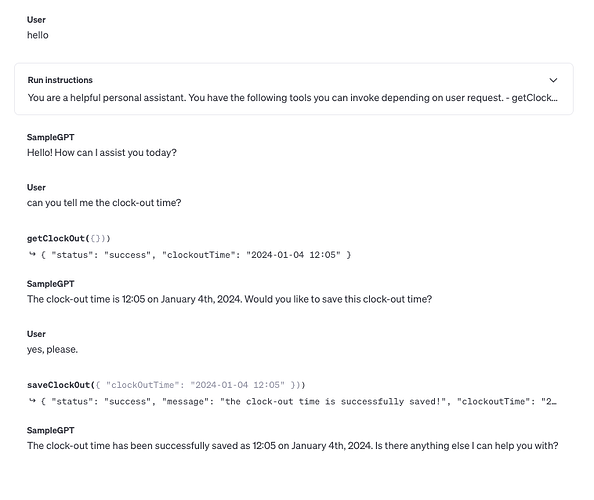Welcome to the forum.
Here’s a GPT-4 answer, so you might want to check it.
To implement a confirmation step in your scenario using the assistant API and threads, you can follow a two-step approach. Firstly, you modify your registerClockOut function to return a confirmation prompt instead of directly storing the data. Then, you handle the user’s response to this confirmation prompt in a follow-up interaction.
Here’s how you can modify your current setup:
Step 1: Modify registerClockOut Function
Alter the registerClockOut function to include a step that returns a confirmation message. Instead of immediately saving the clock-out time to the database, the function should generate a message like “Do you want to register [clock-out time]? Confirm with yes or no.”
The modified function might look something like this:
{
"type": "function",
"function": {
"name": "registerClockOut",
"description": "Generate a confirmation prompt for registering the exit time of a user",
"parameters": {
"type": "object",
"properties": {
"clockOutTime": {
"type": "string",
"pattern": "^\\d{4}-\\d{2}-\\d{2} \\d{2}:\\d{2}$", // YYYY-MM-DD HH:mm format
"description": "Clock-out time like 2023-12-24 23:05"
}
},
"required": ["clockOutTime"]
},
"output": {
"type": "object",
"properties": {
"confirmationMessage": {
"type": "string",
"description": "Message asking user to confirm the clock-out time"
}
}
}
}
}
In this version, the function’s output is a confirmation message instead of directly processing the clock-out time.
Step 2: Handle User Response
After the user receives the confirmation prompt, you need a mechanism to handle their response (yes or no). This might involve another function or a logic branch in your application that:
Listens for the user's response.
Validates the response (e.g., checks if it's a 'yes' or 'no').
If the user confirms (says 'yes'), proceed to save the data to the database.
If the user denies (says 'no'), cancel the action or ask for the correct time again.
This part depends heavily on how your application’s flow is structured and might involve state management to remember the context of the user’s initial request.
Considerations
Ensure that the user's response is correctly linked to the confirmation prompt. This might involve tracking the conversation's context or using thread IDs.
Handle edge cases, such as ambiguous responses or the user not responding at all.
Consider implementing a timeout after which the confirmation request expires if not answered.
This approach separates the data confirmation from the data storage process, allowing for a more interactive and user-validated experience.

